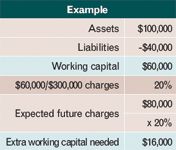Article
How much cash do you need?
The money used to run a practice is called working capital. Having positive working capital means your practice is able to pay off its short-term liabilities, such as payroll, supplies and rent.

Key Points

Even after funding a practice start-up, it still takes money to keep the practice running. You can have a full patient schedule, but without cash, you can't pay your bills. Even if you have a concierge style cash-only practice and don't accept insurance reimbursement, you still have to rent the office, hire staff, and buy supplies in advance in order to see that cash-paying patient. You may have to periodically paint the office, replace the carpet, or fix a broken EKG or other equipment. You can use your own money ("current assets") or you can borrow-or owe-it (long- or short-term liabilities).
The money used to run a practice is referred to as working capital. Working capital equals your current assets minus your current liabilities. Having positive working capital means that your practice is able to pay off its short-term liabilities such as payroll, supplies, and rent. Having negative working capital means that your practice is unable to meet its short-term liabilities with its current assets including cash, accounts receivable, and inventory. The worst-case end-result of ongoing negative working capital is bankruptcy, when you can no longer pay your bills.
The period between having positive working capital and bankruptcy can be quite complex, and certainly stressful. Having it be stressful is better, though, than having it go unnoticed. Paying attention to your practice's working capital ratio can give you an advance "yellow flag" warning of something going wrong, hopefully in time to fix it. For example, noticing that the accounts receivable due more than 90 days are climbing, while the checking account balance is dwindling, should prompt you to look into the reasons why. Other warning flags may include your bookkeeper coming to you with concerns or the need to dip into your practice's line of credit to put money into the practice to make payroll.
Working capital can be used as a barometer of a practice's operational efficiency. Accounts receivable that are increasing also increase working capital and on the surface would appear to be a good thing. But if your accounts receivable are increasing because your collections activity has slowed-as is common in this economy-it can mean trouble.
Money that is owed to the practice cannot be used to pay current bills. Accounts receivable more than 90 days old may not really be an asset, as the older they get, the less likely it is that they will ever be converted into cash. So if a practice is not operationally efficient, that will be reflected in the working capital. Having a lot of your working capital tied up in accounts receivable instead of cash is inefficient and can lead to trouble, as there are better uses for your cash. The same goes for having your cash tied up in equipment that is not being used efficiently to create profits, like that hair-removal cosmetic laser you never got around to marketing effectively (even though you and your staff are now largely hairless).
HOW MUCH DO YOU NEED?

One way to forecast how much more cash is needed is to calculate last year's working capital (assets minus liabilities) and divide the amount by last year's charges. Then multiply the ratio times the projected future charges to calculate capital needed.

The costs of running a practice generally go up each year. Aside perhaps from computers and software, the price of most things rises-particularly staffing costs. At the same time, reimbursement from insurance plans often is flat or declining. In order to preserve working capital and not fall behind, physicians have to either work smarter or work harder; and how much harder can you work?
This brings us back to the first sentence of this article: "It takes money to make money." Balancing the cash income and outflow is often referred to as revenue cycle management. Revenue cycle management is very important in labor-intensive businesses like medical practices. It can often be deployed with minimal capital. Proper use of capital to invest in strategies that yield a return on investment without additional physician labor also improves working capital.
Here are some monthly benchmarks to watch to keep track of changes in key working capital:





